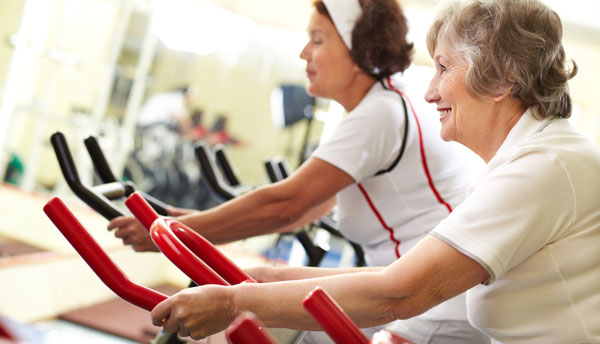|
I don’t know about you but winter weather doesn’t motivate me to exercise. Often it’s cold and wet outside, the days are darker and it feels a lot more comfortable spending an evening inside on the couch. However, as much as I enjoy the warmth indoors, I know I’m missing out on the benefits of exercise and the mobility it can give me in the colder months.
People often say to me that as they get older they notice more pain in their joints and muscles and as the weather gets colder the pain and discomfort also increases.
Colder weather can often aggravate joint sensitivities which may be caused by old injuries, inactivity, aging and conditions like osteoarthritis. This further reduces the desire to exercise but this lack of activity can make the situation worse.
It is important to know why exercise is good for your joints all year round and why it is crucial to keep going in winter, even when it feels like the last thing you want to do.
Why is joint pain more noticeable in winter?
There are many possible reasons why cold weather contributes to joint pain. For many years people have experienced flare-ups of pain when the weather cools down. Potential factors which could contribute to pain and stiffness in the joints include humidity, temperature, precipitation and barometric pressure.
Recent studies done by researchers in Europe have shown that pain and stiffness tends to become slightly worse in arthritis sufferers when there is a rise in humidity and barometric pressure, especially in colder weather. (1)(2)
This may explain why some people may feel worse in colder conditions while other people may feel no change.
If there can be a connection made between the joint pain symptoms and a particular type of weather pattern such as high humidity or barometric pressure, this may help identify preventative measures people can take to ease the suffering. (3)
How does exercise benefit joints and help with discomfort in winter?
Exercise helps synovial fluid move around the joint, ensuring it gets a good supply of nutrients as blood circulates around the body. (4)
Regular physical activity has been shown to improve weight control. (5) Keeping weight down is important as when you are exercising weight bears down and compresses your joint so obviously the less weight on the joint the better. (6)
As the weight gets lifted valuable nutrients travel to the joint to support and lubricate cartilage, which cushions the joint. If there is not sufficient lubrication from the synovial fluid, bone surfaces can touch and this results in pain and inflammation around the surrounding joint tissues. (7)
Exercise can also help with repairing cartilage which has been destroyed from conditions like osteoarthritis.
Although it is easier to be a couch potato and not exercise, the benefits of incorporating a little exercise into your life are tremendous for your overall health, whether you are a little older, overweight or an athlete.
Strengthening the joints in winter can help reduce pain and improve mobility. (8) However, it is important that people are careful with the technique they use to reduce the risk of injuries and keep exercise safe. Warming up, cooling down and stretching are important to protect your joints and muscles. (9)
A combination of a healthy amount of physical activity, good eating and a powerful supplement with ingredients to target the pain and discomfort may help you through the days of winter.
Indoor exercise alternatives

- Join a gym – you can pursue similar activities that you may have done during the warmer months. Eg. walking on a treadmill, doing a spin cycling class.
- Try indoor classes such as yoga or tai chi – these forms of exercise are great because they are low-impact and can improve flexibility, mobility and strengthen joints and muscles.
- Try a new sporting activity which you can pursue indoors in winter – you may be able to play tennis, table tennis, squash/racquetball, indoor soccer, basketball or go swimming. Boxing or a martial art may also be a good option.
- Get some weights or exercise bands that you can use for resistance training at home to strengthen joints or use any fitness equipment you may have at home. You can also do exercises using your own bodyweight such as squats and push-ups.
- Do housework actively – okay, so it’s not always that interesting but vacuuming the house with vigour and putting some real elbow grease into polishing the tapware can help strengthen your muscles and joints, get your heart rate up and gets it all done faster. You can’t beat a nice clean house.
If you are going outside to exercise in winter make sure you add more layers of clothing and warm up and cool down well. (10), (11)
Partner with joint supplements
Not Just Joints is a combination of effective nutrients which may help the joint fluid levels and assist the nutrients to travel to the cartilage. Ingredients such as Turmeric extract have been shown in many studies to be beneficial for helping people with pain associated with arthritis. (12) Other ingredients include glucosamine and chondroitin which naturally occur in cartilage and can help with joint health. (13)
Not Just Joints helps manage chronic inflammation in the joint area and reduce the destruction of cartilage. Getting important nutrients traveling to the cartilage to protect the joints and bones is crucial and Not Just Joints is designed to combat more severe joint damage and pain. Used alongside
Green Lipped Mussel Powder for maximum potency this can help you get back to a level of mobility and comfort so you can be more active even as the weather cools down.
Is your joint pain worse in winter? Let us know what keeps you motivated to keep active in the colder months.
References
1. http://www.health.harvard.edu/blog/can-the-weather-really-worsen-arthritis-pain-201511208661
2. http://articles.mercola.com/sites/articles/archive/2016/03/20/arthritis-weather-conditions.aspx
3. http://www.jrheum.org/content/early/2015/08/26/jrheum.141594.abstract
4. http://blog.arthritis.org/living-with-arthritis/exercise-benefits-for-joints/
5. https://www.ncbi.nlm.nih.gov/pmc/articles/PMC1402378/
6. https://www.ncbi.nlm.nih.gov/pmc/articles/PMC2667877/
7. http://www.healthline.com/health/osteoarthritis/understanding-aging-and-joints#1
8. http://www.yhep.com.au/documents/JSAMS-Article-Osteoarthritis-of-the-hip-and-knee1.pdf
9. http://www.health.harvard.edu/newsletter_article/exercise-and-your-joints
10. http://www.webmd.com/fitness-exercise/guide/quick-tips-staying-active-in-cold-weather-get-started#1
11. http://www.bloomberg.com/news/photo-essays/2011-03-07/the-best-indoor-sports-for-outdoor-athletes
12. https://www.ncbi.nlm.nih.gov/pubmed/27533649
13. https://nccih.nih.gov/research/results/gait/qa.htm
|

 Youre Not Getting Enough Vitamin B6
Youre Not Getting Enough Vitamin B6  Fish Oil Relieves Joint and Back Pain, Reducing Need for NSAIDs
Fish Oil Relieves Joint and Back Pain, Reducing Need for NSAIDs  Being Fit does not always mean Healthy
Being Fit does not always mean Healthy 
 Youre Not Getting Enough Vitamin B6
Youre Not Getting Enough Vitamin B6  Fish Oil Relieves Joint and Back Pain, Reducing Need for NSAIDs
Fish Oil Relieves Joint and Back Pain, Reducing Need for NSAIDs  Being Fit does not always mean Healthy
Being Fit does not always mean Healthy